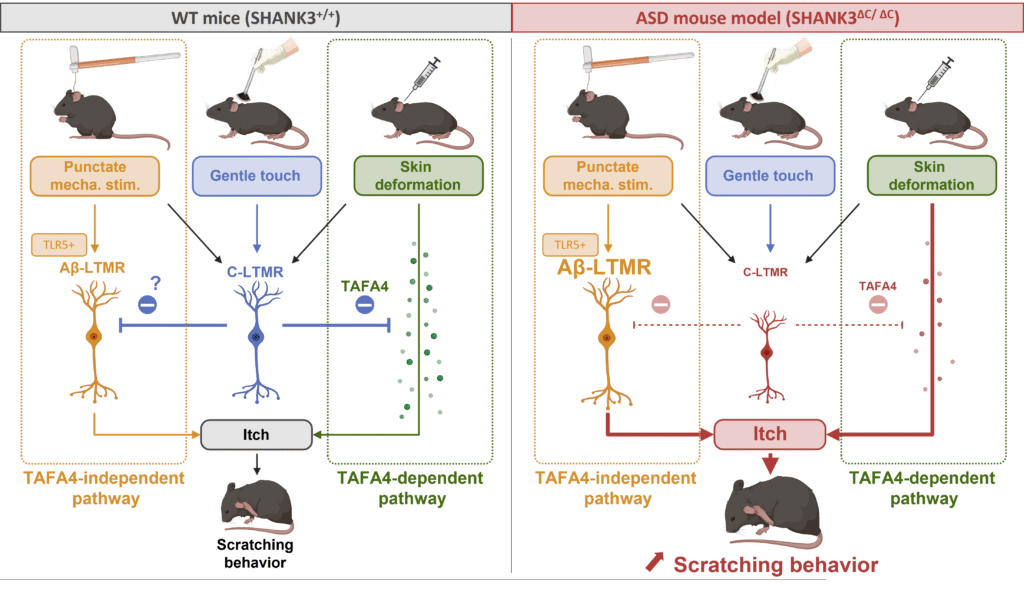Autism Spectrum Disorder (ASD) is a developmental condition that affects social interactions and how individuals perceive their environment. Many autistic people experience touch differently: some are overly sensitive to it, while others respond very little. Interestingly, individuals with ASD also tend to have more frequent skin issues, such as eczema or itching, though the reasons for this link remain poorly understood.
In this study, the team “Neuronal networks for affective and social touch” headed by Amaury François, in collaboration with the team “Calcium channel dynamics and nociception” headed by Emmanuel Bourinet, aimed to explore whether dysfunction in the neurons responsible for detecting touch could explain both altered touch sensitivity and skin disorders observed in autism. To investigate this, they used a mouse model carrying a genetic mutation associated with a form of autism (Phelan-McDermid syndrome) and found that these mice displayed increased scratching behavior in response to light skin contact, suggesting hypersensitivity to mechanical itch.
The authors discovered that certain sensory neurons involved in the perception of pleasant touch (called C-LTMRs) functioned abnormally in these mice, making them less responsive to such stimulation. Interestingly, by restoring the activity of these neurons, either through injection of a neuropeptide mimicking their effect or by gently stimulating the skin (such as with stroking), they observed a significant reduction in scratching behavior. These findings suggest that C-LTMRs play a crucial role in regulating itch and that their dysfunction may contribute to the skin problems often seen in ASD.
This research thus helps to better understand the link between touch sensitivity and skin disorders in ASD and opens new avenues for potential therapeutic strategies.
This work was accepted for publication in Translational Psychiatry.

Hypothetical diagram of two distinct pathways involved in itch control and scratching behavior in Shank3ΔC/ΔC mice.
Our experiments identified two separate pathways responsible for scratching behavior in response to tactile stimuli: punctate mechanical stimulation (defined as direct, external mechanical pressure, highlighted in orange) and skin deformation (characterized by localized mechanical distortion, such as following an intradermal injection, highlighted in green). The response to punctate mechanical stimulation is primarily mediated by TLR5-expressing A-LTMR fibers and is hypersensitive in Shank3ΔC/ΔC mice, leading to an alloknesis phenotype (excessive itch responses to mechanical stimuli). In contrast, skin deformation induces scratching that can be reduced by TAFA4 treatment in Shank3ΔC/ΔC mice. However, TAFA4 does not reduce alloknesis, suggesting that the response to skin deformation is TAFA4-dependent, whereas the mechanical itch response is TAFA4-independent. Shank3ΔC/ΔC mice, which display a functional deficit in C-LTMR fibers, show increased itch sensitivity in both cases. TAFA4 supplementation was only able to rescue the spontaneous scratching response to skin deformation, but not the hypersensitivity to alloknesis in Shank3ΔC/ΔC mice.


